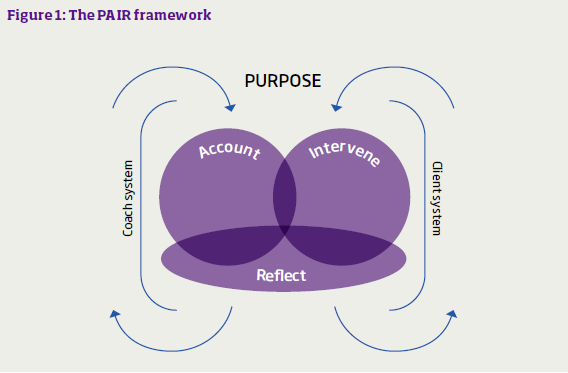As coaches, we work with clients who have unique goals, needs, perspectives and experiences. The ability to navigate such diversity is a hallmark of the effective coach, but knowledge of how to systematically tailor our methods to accommodate individual differences remains limited. How then, can we design and deliver coaching assignments that are responsive to individual need and yet remain ‘grounded’ in the formal knowledge base of our field?
One approach that holds promise in enabling coaches to respond to individual differences while remaining disciplined in their thinking is case formulation. While the application of case formulation is considered a core competence for skilled psychological practice,1 it is an emerging practice in the field of coaching.2,3 In this article, therefore, we consider three main questions:
- What is case formulation, and what is its function in a coaching context?
- How do you get started with, or refine your approach to, case formulation?
- What are the challenges of applying case formulation in coaching and how can we overcome them?
Applying case formulation to a coaching context
In general terms, a case formulation is an explanatory account of the issues, dilemmas, goals and situational factors with which a client presents.1 The development of this account assists practitioners in understanding clients’ needs and context, and supports coaches in tailoring their style, approach and focus to increase the likelihood of a beneficial outcome.
Although not universally upheld as essential to enabling change (see, for example, Crellin,4 writing in the context of clinical psychology, from where the concept originated), we have found that the approach can be adapted to the coaching context and is helpful on a number of levels. For one of us (LK), applying formulation has been a useful tool in dealing with the complexity of executive coaching cases where there are many intertwined elements at both the individual and organisational level. Developing a comprehensive picture of these elements and how they interact has been beneficial in making sense of the situation, identifying the key areas of focus for the coaching and designing an individualised approach. For the second author (SC), case formulation has provided a way of better navigating ambiguity and uncertainty, enhancing client empathy, and having a means of bringing rigour to the testing of hunches and intuitions. Additional ways in which a case formulation can aid coaching are included in Box 1.
The PAIR framework
Although the professional practice literature provides some general principles on why case formulation can be beneficial, what is less clear is how specifically case formulation can be used as a tool within coaching. Original research conducted by one of us (LK) attempted to address precisely this issue. Through developing and testing the PAIR (Purpose-Account-Intervene- Reflect) framework (see Figure 1), Kovacs3 has attempted to offer a coaching-specific approach to formulation that coaches can use to better understand and respond to the idiosyncratic needs with which clients present. The PAIR framework, along with some suggestions on how to apply it, is described below.

Purpose
The starting point for developing a coaching account is to establish the purpose of the coaching. In contrast to a case formulation devised for therapeutic purposes (which typically starts with a full description of the presenting problems), coaching is usually more future and solution focused. Therefore, the aims and objectives, along with an exploration of what will ideally be different at the end of coaching, may be a more appropriate starting point.
Agreeing its primary purpose sets the coaching assignment within agreed boundaries that provide enough scope to explore the complexity of the client’s situation while ensuring that the work remains sufficiently focused on, and organised around, the intended aims. The ‘Purpose’, as understood within the PAIR framework, clarifies broad aims rather than specific goals. For example, in an executive coaching context, the purpose could be defined as one of increasing a leader’s ability to adopt an empowering leadership style. Specific goals organised around behavioural changes appropriate to the client’s context (such as increasing effective delegation) may be subsequently agreed, but only once the purpose of the work has been negotiated.
Account
The ‘Account’ element of the PAIR framework is, in some respects, the most labour-intensive stage of the formulation process, relying on a potentially wide range of methods of data-gathering and the coach’s ability to synthesise these data into a coherent understanding that can form the basis of an action plan. The coaching account has three elements: (1) exploration; (2) generating ideas and (3) designing the process, as outlined below:
1. Exploration
The process of developing the account begins as soon as you begin interacting with a client. As the coaching proceeds, more information is uncovered, ideas are tested, actions or interventions occur and the results are evaluated. As a result, the account is continually revised and the process of exploration is very much an iterative one.
How you decide what information to gather and what factors to consider will, to a large extent, be guided by your perspective as a coach – whether philosophical, theoretical, or model driven (or any combination of these and other worldviews that shape how you understand your role as a coach). Your perspective will guide not only what information you consider to be relevant but also the approach that you are likely to favour. In developing your account, it can be useful to consider the following questions to ensure that you are not attempting to fit the client to your perspective, but are taking a broad view of the client’s needs and the factors involved in the request for coaching:
- What perspectives do I bring to this coaching assignment (including theoretical perspectives, beliefs about coaching, prior training, my own professional experience and any culturally embedded beliefs about human nature and change work)?
- How will these perspectives influence how I see the situation and inform the development of the account?
- What information might I miss if I only consider these perspectives? What other perspectives might be useful (whether to extend my existing understanding or to help me critique my usual approach)?
- How will I capture the client’s perspective in my account?
To continue with the example of the executive coaching assignment, a coach could explore the issue of leadership development from many different perspectives. A systems approach would consider factors at both the organisational and individual level and the interactions between the many factors involved. Trait-based perspectives can contribute to an account informed by personality theory, focusing the coach’s attention on a variety of influential individual factors inherent in the person. Each may be a valid perspective and contribute something to the overall picture, but it is critical to understand how each perspective shines only one type of lens on the issue at hand. Considering your perspectives at this stage can also aid you in deciding whether the coaching services you offer are a good fit for a particular client (whose perspectives may be very different from your own).
2. Generating ideas
As you gather information you begin to generate ideas about how you might work with the client. Coaches often begin to ‘formulate’ hunches, hypotheses and mini theories as soon as they start their conversations with clients. Articulating these emerging theories in your account helps make the process of idea generation explicit and, therefore, amenable to sharing and testing out. This might be as simple as sharing your ideas or asking additional questions, but may also involve using diagnostics or trying out a particular technique or intervention. All of these actions will provide more information that can be incorporated into your account and which may confirm or challenge your initial ideas.
3. Designing the process
Having developed your ideas about how to approach the assignment, a coaching process can be designed. Some questions to consider at this stage are:
- Based on the account of the factors involved, where are you likely to get the most effective results?
- What approaches are most appropriate?
- What barriers to success can you anticipate and what strategies will you use to help the client overcome them?
- Looking at the factors you have identified, are there elements that require a therapeutic approach? If so, how will you address these? (This may include recommending that the client seeks the services of another kind of professional.)
- What measures or feedback mechanisms will assist in monitoring progress?
- How much of your account will you share with the client? How involved will the client be in designing the coaching process?
Intervene
The ‘Intervention’ phase of the PAIR framework is a logical extension of the coaching account. Throughout the intervention, the coach will continue to gather information that can be used to update and (where necessary) revise the coaching account. If your approach is not obtaining the expected results, revising your account can be supported by asking yourself the following questions:
- What factors could be getting in the way of progress? Are there other factors that I haven’t yet considered?
- Is there another perspective or approach that would be useful at this stage?
- What feedback has the client provided on how they are experiencing the coaching?
- Do the client and I have the right measures of progress in place?
Alternatively, if the coaching is progressing well towards the agreed purpose, reviewing and updating the account can be an effective way of capturing your learning. In seeking to generalise from one successful coaching assignment to others, it helps to spend time reflecting on the most important contributors to progress, identifying any interventions that seem to have gained the most effective results and eliciting the client’s feedback on what has been most helpful to them.
Reflection
If working effectively, the account will remain a central support for the coach throughout the coaching assignment and an important aid to reflective practice. In addition to enhancing the effectiveness of coaching, the process of reviewing and updating the account serves to deepen the coach’s thinking about the client, the coaching process, the factors implicated in the extent of its effectiveness and the coach’s own learning. The account can also provide a useful framework for reflection with the client; a co-constructed understanding of relevant factors enables the client to collaborate on developing the solution, which can enhance the likelihood of the client ‘owning’ the work that unfolds.
Reviewing the account between sessions may pinpoint links and connections that, once identified, can stimulate new insights or ideas to test with the client in future sessions. It is an opportunity to review your hypotheses and consider your understanding from different perspectives; for example, through the lens of alternative theoretical approaches. This is also a chance to consider the coach-client relationship and dynamics, which can be a source of insight as well as a point at which to consider if a supervision session is needed. The account can support the coach in presenting the case to a supervisor or supervision group and to jointly review your thinking and subsequently revise the account.
The challenges of using formulation
As you develop your skill in formulation there are a number of challenges that you may encounter. First, there can be a temptation to try to develop the ‘perfect’ account. However, the aim of the account is to help you organise your thinking. As such, there is no ‘right’ amount of information or ideas. Writing from within the clinical field, Gillian Butler5 even questioned the need for formulations to be totally accurate, claiming that the primary emphasis should be on generating questions and ideas that can add richness to the work. Formulation is best understood as an iterative process where you can expect to modify your understanding and approach as the coaching proceeds.
A second challenge can arise when you have captured a lot of information and find yourself becoming lost in the complexity. At this point, you need to start to filter the information, based on the results of testing some of your ideas, working with the client to prioritise issues and selecting the areas where the client has the most control or likelihood of success.
A third point to highlight is that some clients may bring to the work an expectation that coaching is action oriented, and so seek evidence of tangible results from the first conversation. Where this occurs, you can use this energy to agree some actions with the client that will enable targeted information-gathering, or small ‘experiments’ to help you test out some of your initial ideas.
Finally, you will also have to decide at which point to share your thinking with your client – and how much of it to share. There is no single, correct approach here; the coach will need to decide what is most appropriate, based on their evaluation of the readiness of the client for insights that might result in their feeling exposed. Some factors to consider in deciding the level at which to share your account are the client’s readiness for change, level of self-awareness, their knowledge of psychological principles and current levels of overall wellbeing.
Finally…
Case formulation is well embedded within applied psychology and the healthcare field. However, it has much to offer coaching practitioners also. Dual-trained coaches, in particular, may be especially well placed to apply formulation to their practice, given their pre-existing knowledge of theories, models and how to establish collaborative working relationships for the purposes of addressing difficult or sensitive issues. Indeed, given this bedrock of knowledge and experience, dual-trained practitioners could lead the way in embedding case formulation in coaching practice.
In exploring its application to coaching we recognise that case formulation is contentious and will be rejected by some as the imposition of the coach’s worldview on the client. But in our experience, if used appropriately, it is a valuable skill for coaches to have in their toolkit. It is never the aim of formulation to put clients in boxes so that we can construct explanations and solutions that suit our own thinking. Rather, as the PAIR (Purpose-Account-Intervene-Reflect) framework conveys, formulation is a vehicle for organising and making explicit your thinking. Used well, it facilitates creative ideas that can support you in learning more about what makes your clients unique and how you can use those unique qualities to create even better outcomes – for the benefit of all involved.
Sarah Corrie is a Past Chair and the current Research Officer of the British Psychological Society’s Special Group in Coaching Psychology. A Visiting Professor at Middlesex University, Sarah has extensive experience in both public and private sector services and runs her own coaching practice as well as working as a freelance supervisor and trainer. She is the author of numerous articles and seven books, including The Art of Inspired Living: Coach Yourself with Positive Psychology (Karnac), and is co-author of CBT Supervision (Sage) and of Supervision in the Psychological Professions: Building your own Personalised Model (OU Press). www.sarahcorrie.com.
Louise Kovacs is a coaching practitioner-researcher based in Singapore. She has been an executive coach since 2005 and works with organisations and their senior leaders across the Asia Pacific region. Prior to her coaching career she had a successful sales and marketing career in the IT industry. Louise recently completed her doctor of professional studies programme in executive coaching through Middlesex University and holds a master’s degree in HR management and coaching psychology from the University of Sydney.
More from Coaching Today

Coaching for health: why the time is now
Open article: Following the publication of her new book, 'Coaching for Health', author Jenny Rogers explains why a coaching approach by our healthcare professionals benefits clinicians and patients alike. Coaching Today, January 2017

The sports coach meets the executive coach: what can we learn from sports coaching?
Open article: In the first of this two-part series, Erik de Haan and Pat McCarry review the role of the contemporary, elite sports coach and consider the skills that might be realistically applied to coaching in other contexts. Coaching Today, October 2016

Why I became a coach: Depth and breadth
Open article: Executive coach and BACP Coaching Executive member Michèle Down describes her own journey into coaching. Coaching Today, July 2016
References
1 Corrie S, Lane DA. Constructing stories, telling tales: a guide to formulation in applied psychology. London: Karnac; 2010.
2 Lane DA, Corrie S. Does coaching psychology need the concept of formulation? International Coaching Psychology Review 2009; 4(2): 195–208.
3 Kovacs LC. Enabling leaders to navigate complexity: an executive coaching framework. Unpublished doctoral thesis, Middlesex University; 2016.
4 Crellin C. Origins and social context of the term ‘formulation’ in psychological case reports. Clinical Psychology Forum 1998; 112: 18–28.
5 Butler G. Clinical formulation. In Bellack AS, Hersen M (eds). Comprehensive clinical psychology, volume 6. Oxford: Pergamon; 1998 (pp1–24).
